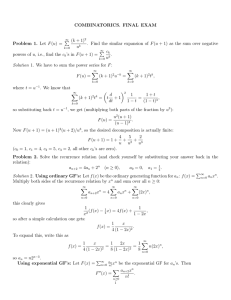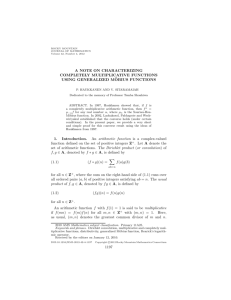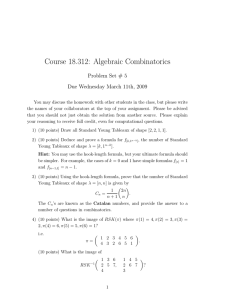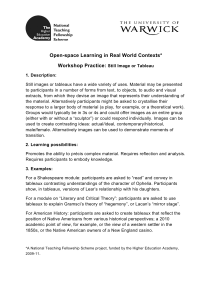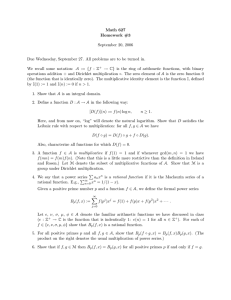COMBINATORICS. FINAL EXAM (k + 1) P Problem 1. Let F (u) =
advertisement
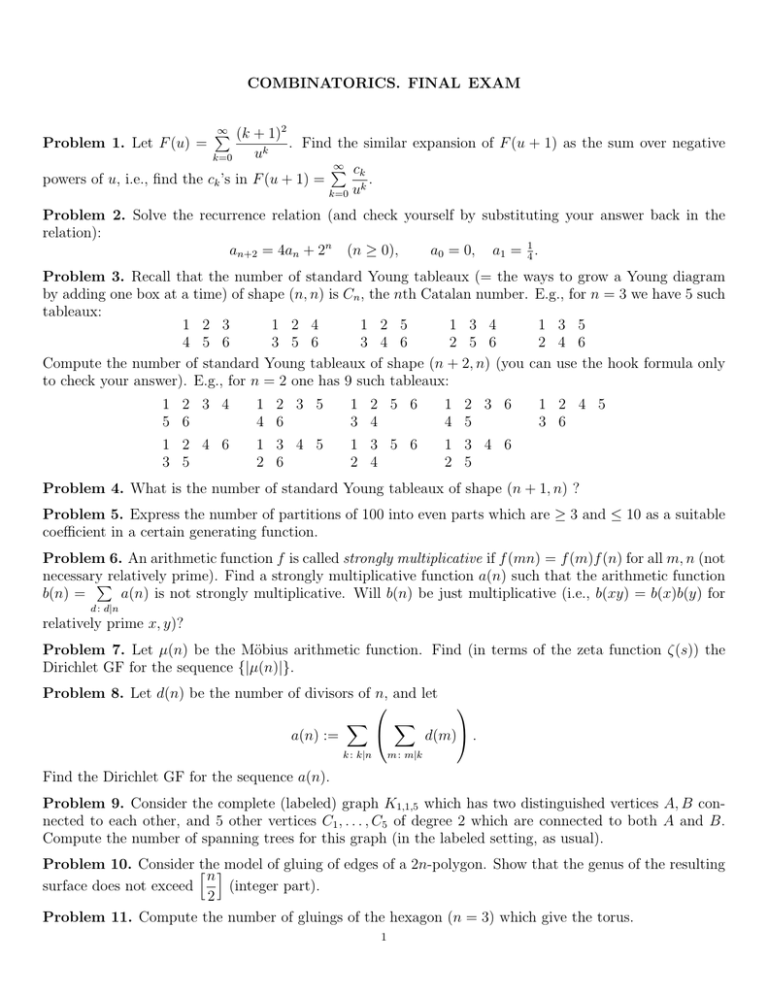
COMBINATORICS. FINAL EXAM
∞ (k + 1)2
P
. Find the similar expansion of F (u + 1) as the sum over negative
uk
k=0
∞ c
P
k
powers of u, i.e., find the ck ’s in F (u + 1) =
.
k
u
k=0
Problem 1. Let F (u) =
Problem 2. Solve the recurrence relation (and check yourself by substituting your answer back in the
relation):
an+2 = 4an + 2n (n ≥ 0),
a0 = 0, a1 = 14 .
Problem 3. Recall that the number of standard Young tableaux (= the ways to grow a Young diagram
by adding one box at a time) of shape (n, n) is Cn , the nth Catalan number. E.g., for n = 3 we have 5 such
tableaux:
1 2 3
1 2 4
1 2 5
1 3 4
1 3 5
4 5 6
3 5 6
3 4 6
2 5 6
2 4 6
Compute the number of standard Young tableaux of shape (n + 2, n) (you can use the hook formula only
to check your answer). E.g., for n = 2 one has 9 such tableaux:
1 2 3 4
5 6
1 2 3 5
4 6
1 2 5 6
3 4
1 2 3 6
4 5
1 2 4 6
3 5
1 3 4 5
2 6
1 3 5 6
2 4
1 3 4 6
2 5
1 2 4 5
3 6
Problem 4. What is the number of standard Young tableaux of shape (n + 1, n) ?
Problem 5. Express the number of partitions of 100 into even parts which are ≥ 3 and ≤ 10 as a suitable
coefficient in a certain generating function.
Problem 6. An arithmetic function f is called strongly multiplicative if f (mn) = f (m)f (n) for all m, n (not
necessaryPrelatively prime). Find a strongly multiplicative function a(n) such that the arithmetic function
b(n) =
a(n) is not strongly multiplicative. Will b(n) be just multiplicative (i.e., b(xy) = b(x)b(y) for
d : d|n
relatively prime x, y)?
Problem 7. Let µ(n) be the Möbius arithmetic function. Find (in terms of the zeta function ζ(s)) the
Dirichlet GF for the sequence {|µ(n)|}.
Problem 8. Let d(n) be the number of divisors of n, and let
X
X
a(n) :=
d(m) .
k : k|n
m : m|k
Find the Dirichlet GF for the sequence a(n).
Problem 9. Consider the complete (labeled) graph K1,1,5 which has two distinguished vertices A, B connected to each other, and 5 other vertices C1 , . . . , C5 of degree 2 which are connected to both A and B.
Compute the number of spanning trees for this graph (in the labeled setting, as usual).
Problem 10. Consider htheimodel of gluing of edges of a 2n-polygon. Show that the genus of the resulting
n
surface does not exceed
(integer part).
2
Problem 11. Compute the number of gluings of the hexagon (n = 3) which give the torus.
1
2
COMBINATORICS. FINAL EXAM
Supplementary problems
Problem 12. Express the number of integer solutions of the equation
a + b + c = 100
with constraints 60 ≥ a ≥ b ≥ c ≥ 4 as a suitable coefficient in a certain generating function. (Hint: you
will need a two-variable generating function.)
Problem 13. Let λ be the multiplicative function such that λ(pk ) = (−1)k (p prime). Prove that
(
X
1,
n is a square,
λ(d) =
0,
otherwise.
d : d|n
Problem 14. Solve Problem 9 for K1,1,n .
Problem 15. Compute the number of gluings of the octagon (n = 4) which give the torus.
